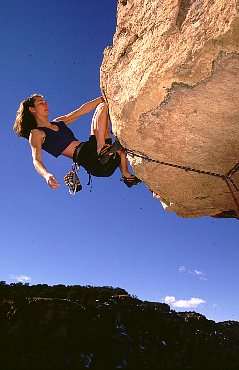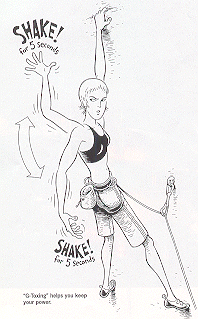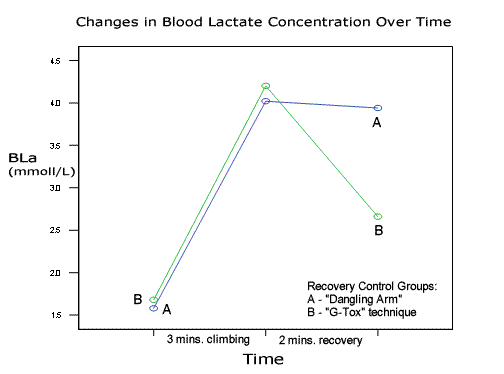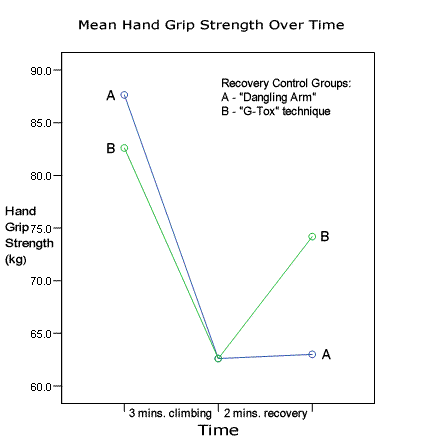Study Shows "G-Tox" Accelerates Recovery
 The "dangling arm" shakeout is commonly used to facilitate forearm recovery while on a climb. A few seconds or, hopefully, a few minutes of "shaking out" provides some recovery, but often not enough. The effects of a muscular pump can take frustratingly long to subside and, when hanging out at a marginal rest, it's possible to expend as much energy hanging on with the one arm as is being recouped in the other. Such a zero-net gain in recovery does nothing to enhance performance--in such a situation, you would likely fare better by blowing off the so-called rest and climbing onward.
The "dangling arm" shakeout is commonly used to facilitate forearm recovery while on a climb. A few seconds or, hopefully, a few minutes of "shaking out" provides some recovery, but often not enough. The effects of a muscular pump can take frustratingly long to subside and, when hanging out at a marginal rest, it's possible to expend as much energy hanging on with the one arm as is being recouped in the other. Such a zero-net gain in recovery does nothing to enhance performance--in such a situation, you would likely fare better by blowing off the so-called rest and climbing onward. Luckily, there is a more effective method of refreshing your forearms that the majority of climbers ignore or are not aware of. For more than a decade I have been promoting the benefits of alternating the position of your resting arm between the normal "dangling" position and an above your head "raised-hand" position. This simple practice provides a marked increase in recovery rate--I call this accelerated recovery technique the "G-Tox", because is uses gravity (an ally, for once) to help detoxify the fatigued forearm muscles and accelerate recovery.
British researcher, Luke Roberts, recently decided to put G-Tox to the test. He compared recovery rates (as measured by blood lactate and grip strength) of climbers using the G-Tox technique versus a control group of climbers employing the standard dangling-arm shakeout. The results showed a statistically significant (p<0.05) increase in recovery among the group of climbers using the G-Tox. (See graphs below of blood lactate response and grips strength.)
Drawing: Courtesy of Clelland/Climbing mag (from Horst article "Slowing the Pump Clock, July 2004 issue)
Why G-Tox Works
 The discomfort and pump that develops in the forearms while climbing is largely the result of accumulating lactic acid (LA) and restricted blood flow. LA is a byproduct of the anaerobic metabolism of glycogen, an energy pathway that comes into use during extended contractions of greater than about 50 percent of maximum intensity. Worse yet, contractions of as little as 20 percent of maximum intensity begins to hamper capillary blood flow, and at 50 percent contraction blood flow may be completely occluded (closed off). As a result, LA concentrations skyrocket until blood flow can resume during periods of low-intensity contraction or complete rest.
The discomfort and pump that develops in the forearms while climbing is largely the result of accumulating lactic acid (LA) and restricted blood flow. LA is a byproduct of the anaerobic metabolism of glycogen, an energy pathway that comes into use during extended contractions of greater than about 50 percent of maximum intensity. Worse yet, contractions of as little as 20 percent of maximum intensity begins to hamper capillary blood flow, and at 50 percent contraction blood flow may be completely occluded (closed off). As a result, LA concentrations skyrocket until blood flow can resume during periods of low-intensity contraction or complete rest. What's more, when dangling you arm at a shakeout technique it's common to experience an initial increase in the sensation of "being pumped." This is because, as the muscle relaxes, blood flow resumes into the muscle, however, venous return of the "old blood" out of the muscle is more sluggish. This "traffic jam" perpetuates the pump and slows recovery, yet many climbers continue to dangle their arms and complain about how sickening a pump they have.
The G-Tox technique puts gravity to work by aiding venous return of blood back toward the heart. By helping get blood out of the arm more quickly, this practice enhances the removal of lactic acid and should allow for a faster return of grip strength. The effects of this technique are unmistakable--you will literally see your pump "drained" as you elevate your arm. (It's interesting to note that arterial flow into the arm is less affected by gravity.)
So, why not just use the raise-arm position for the full duration of the rest instead of using the alternating technique as described above? Since the "raised-arm" position requires some muscular contraction in the upper arm, shoulder, and chest, these muscles would fatigue and possibly hamper climbing performance if you held the raised-arm position for a long time. Consequently, the best protocol for recovery is alternating between the two arm positions every five to ten seconds. Do so, and you will definitely feel the difference the G-Tox makes!


(Note that mean BLa levels after climbing where ~4mmoll/L; so the effect of G-Tox on higher levels of BLa is uncertain.)
Used by permission of Luke Roberts, University College Chichester, U.K. © 2005



 Subscribe to Eric's RSS Feed
Subscribe to Eric's RSS Feed
 Subscribe to Eric's RSS Feed
Subscribe to Eric's RSS Feed